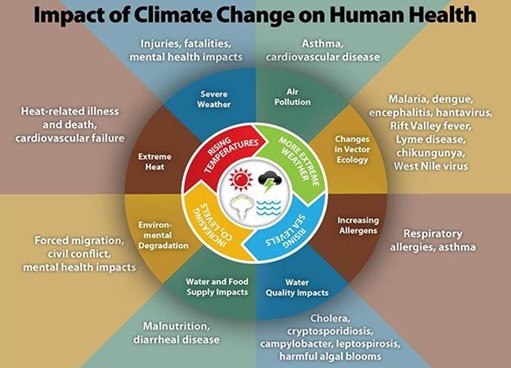
By Hudabieyah Attaria
Imagine that the year we are living in right now is 2050. The sky is choked with smog, hot wind is whistling through sky-scrappers, dust devils are dancing, and the oceans are restless. The world is drowning in oceans and food supplies are cut off. Imagine a world with no light, no power, and no living organisms. The climate is getting worse day by day. Melting glaciers, droughts, migration, increasing sea levels, environmental changes, and devastating ecosystems are not the only outcomes of this phenomenon. The impacts of these changes are even more hazardous. The time for waiting and hoping is over.
“Climate change is a change in the usual weather found in a place. This could be a change in how much rain a place usually gets in a year. Or it could be a change in a place’s usual temperature for a month or season.” Climate change according to NASA.
The 1700s to Present: Tracing the Roots of Climate Change
Global warming is increasing the earth’s temperature, and the main cause is the greenhouse effect. The consequences of climate vary depending on location, as some areas are getting hotter and others are getting even colder. It started in the 1700s when people started using coal energy and burning fossil fuels. The aftermath of World War II led to an increased use of vehicles as transportation. The burning of fossil fuels is directly proportional to the increase in carbon dioxide.
The effects of climate change are making our living place sink into the oceans. As temperatures increase, the glaciers melt, adding more water to the oceans. Since the 1800s, the average sea level has increased by 8 inches, with 3 inches in just the last 25 years.
It may not seem a big deal just an index finger rise but 71% of the earth contains water, and adding more water will put the small islands in danger. The news of the sinking of the capital of Indonesia is not hidden from anyone. The sinking of more land will result in a shortage of supplies like living places and food. The decrease in food and then the increase in population is another threat. The increase in demand and decrease in supplies will lead to poverty and conflict. Extreme weather conditions in Africa may result in forest fires forcing the wild ecosystem to migrate, and in this whole process, millions of rare species would die.
There are over 7,000 glaciers in Pakistan. The exact number is 7253 glaciers, more than anywhere else outside the polar regions. However, rising temperatures are causing increasing glacial melt, which is causing flooding. That is not the only problem though. Climate change is increasing the intensity, frequency, and duration of monsoon rainfalls. This causes a huge rate of migration impacting communities and ecosystems every year. There will be food security issues and water security is already a problem. Ultimately, all these problems will have a huge effect on national security. Hence, this will not only remain a climate issue. Instead, it will become a national security and political issue.
Human Health
Food and water are considered basic needs, but our bodies also require the right temperature to feel good. Unfortunately, climate change is causing extreme weather conditions that are unbearable and causing severe disease, sometimes with no expected treatments. Poor air quality, high ultraviolet rays, and infectious diseases are prominent, but this is not limited to physical health. The survey reports of 2023 prove people are facing mental issues like depression and anxiety due to drastic changes in weather conditions. Even this phenomenon can affect the quality and quantity of food and water. If no steps are taken, extreme weather conditions could lead to over 250,000 deaths by 2025. Some diseases caused by climate change are vector-borne diseases, water-borne diseases, food-borne diseases, diseases, respiratory and heat-related illnesses. High temperatures cause significant risks to human health, particularly during heatwaves and in regions with extreme heat conditions. Continued exposure to extreme temperatures can cause heat-related illnesses like heat exhaustion and heatstroke, resulting in symptoms such as dehydration, dizziness, and even worse, organ failure. Vulnerable populations such as the elderly, infants, and those with chronic illnesses are at heightened risk, with heat waves often linked with increased mortality rates. Beyond physical health, high temperatures can also impact mental well-being, exacerbate air quality issues, and increase the prevalence of waterborne diseases. Furthermore, heat can reduce labor productivity, particularly in outdoor occupations, and worsen health conditions such as cardiovascular diseases and respiratory disorders.
To address these challenges, it becomes very important to implement detailed measures including heatwave early warning systems, public health campaigns, provision of cooling centers, urban planning strategies, and policies to mitigate climate change and reduce greenhouse gas emissions, all aimed at prioritizing human health in the face of rising temperatures.

If the present circumstances go on without any check, then Pakistan is predicted to experience a greater rise in temperature than the world as a whole; the country’s projected temperature increase in the north is anticipated to be greater than in the south. In a nutshell, climate change poses a thoughtful and multi-layered threat to human health, with rising temperatures acting as a primary driving force of worst health outcomes. From intensified heat-related illnesses and mortality during heatwaves to poor air quality, increasing the risk of waterborne diseases, and impacting mental wellbeing, the health impacts of climate change are wide-ranging and severe. Urgent action is required to limit these effects, including efforts to reduce greenhouse gas emissions, adapt to changing climate conditions, and implement policies and interventions aimed at cushioning vulnerable populations. By addressing the root causes of climate change and prioritizing public health in climate adaptation and mitigation strategies, we can work towards a healthier and more resilient future for all.
_______________________
The author is a student of Computer Science at the Women University Multan.

